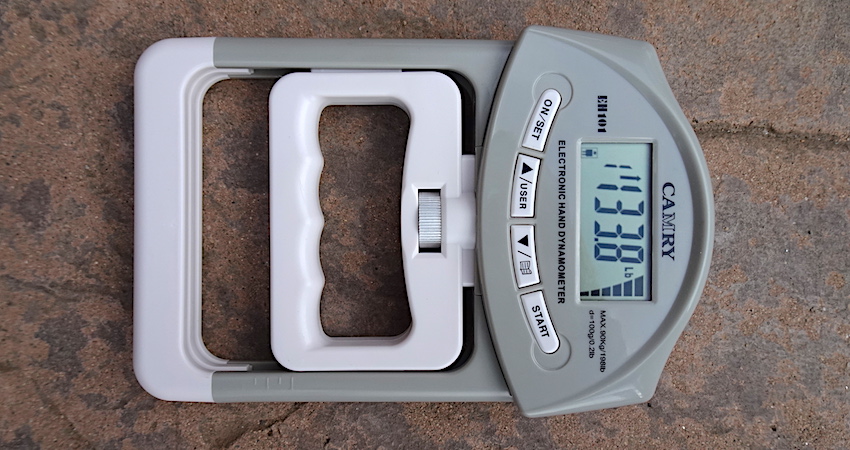
This simple test is a great performance marker for overall health and fitness, in particular full body strength and endurance.
A time-honored test that evaluates overall health and fitness is grip strength. This simple test can be helpful in monitoring athletic performance, aging, full body strength, muscle mass, body fat and even nutritional status.
It’s even a predictor of overall mortality, and you may have been grip tested by a doctor or therapist as it’s commonly used in clinical practice.
We grasp with our hands amazingly well from birth. Healthier newborns, including those full-term, have stronger grips. This represents the integrity and rapid development of the brain’s cortex. While in newborns, this natural reflex component soon subsides, grip strength continues to improve for the next two to three decades, after which regular reductions continue. How rapid this occurs reflects overall health and fitness.
It’s almost as if every health and fitness fault — every physical, biochemical and mental-emotional impairment — large and small, is reflected as further reductions in grip strength. Fortunately, each healthy and fit habit we maintain or create results in improvement of the grip or at least slows the reduction during aging.
While direct localized weakness of hand muscles can occur with brain or spinal injuries, or chronic disuse, more often it’s various other impairments occurring anywhere in the body that can indirectly do the same. This includes weak legs, excess body fat, even poor nutrition.
As a fundamental element of a complete physical examination, a dynamometer, like the one in the picture, measures the maximum isometric strength of the hand and forearm muscles. They are available online for about $30.
Hidden among the many numbers we used to think were primary to health and fitness, such as total cholesterol, scale weight and BMI, calories, and VO2max, predictive measurements are more meaningful for most people. These include evaluating subtle dysfunction, often unsuspecting, asymptomatic problems that precede more well-known serious conditions. These also cause grip strength to wane. Two common examples include:
- Submaximal or aerobic deficiency, which reduces endurance, predicts loss of fitness, and impacts mortality. (See MAF Test.)
- Rising waist-to-height ratio indicates excess body fat even in those with normal weight, itself an early prediction of chronic disease and further physical injury/impairment.
Also, consider that:
-
- If you’re building endurance or full body strength, grip strength improvement indicates training success.
-
- Grip strength is usually reduced if you’re overtrained or burned out, sick or injured, even hospitalized or bed-rested. Use it to monitor recovery as demonstrated by increasing strength.
-
- While grip strength reduces with age, we can offset much of this reduction by building and maintaining overall health, including eating well.
Dexterity
Increased age is often associated with reduced dexterity. This is reflected in slower, less nimble, jerky hand movements, as well as reduced coordination and control of physical performance. This relationship is often a direct consequence of reductions in overall muscle strength. These dexterity factors can be monitored with grip strength.
Dexterity is also an important reflection of neurological function. It includes the ability to control hand movements such as reaching to grasp, steadiness, tracking, aiming, tapping, and touch sensation. These may also be associated with speed of actions, including full body movement.
Although these evaluations are used to monitor aging, they are more reflective of physiological rather than chronological age. Moreover, we can significantly control many factors that reduce the common changes incurred during aging such as full body strength and other neurological function. For example, slowed rate of muscle contraction due to reduced nerve conduction is strongly associated with such lifestyle factors as lower activity levels, increased sitting and poor nutrition. These factors in turn affect joint movement, flexibility, muscle balance, circulation and brain function.
Strength and Diet
Grip strength also correlates with other health and fitness factors. These may include MAF Test results, with improving strength associated with faster speed or increased power. It also relates to increased fat-burning, improved waist-to-height ratio and reduced body fat. Of course, all these measurements are significantly affected by the food we eat. Eliminating junk food, and consuming healthy adequate protein and balanced fats, improves body-wide health and fitness also will be reflected in better grip strength.
What is Normal?
Of course, the answer to this is that there is no normal. Instead, there is a range of grip strength in various age groups, but this reflects a general population who don’t necessarily have higher levels of health and fitness. As a result, these so-called normal ranges all appear quite low when compared to a group of healthy and fit people of the same ages.
Studies show that grip strength in men and women between 20 and 70 years range from 47 to 33, and 30 to 20 pounds, respectively. Yet healthy and fit 65-year old men and women can reach over 100 and 80 pounds, respectively.
More important is personalization, monitoring one’s changes in grip strength over time. Improving full body strength, overall health, and other factors will demonstrate increases in grip strength, while the opposite is reflected in reductions.
Just strengthening your grip (typically with hand-grip exercises) is not the answer to improving grip strength. While you will accomplish this to some extent, improving whole body strength in particular, and overall health and fitness, regardless of age, will improve grip strength even without performing hand-grip exercises.
Grip strength is an effective, easy and inexpensive way to monitor your health, and fitness and improvements. It’s simple: Test to determine strength, make lifestyle improvements, retest. In short, get a grip!
References
Amaral CA, et al. Hand grip strength: Reference values for adults and elderly people of Rio Branco, Acre, Brazil. PLoS One. 2019; 14(1). doi: 10.1371/journal.pone.0211452
Barrea L, et al. Association between Mediterranean diet and hand grip strength in older adult women. Clin Nutr. 2019;38(2). doi: 10.1016/j.clnu.2018.03.012.
Dodds RM, et al. Grip Strength across the Life Course: Normative Data from Twelve British Studies. PLoS One. 2014; 9(12). doi: 10.1371/journal.pone.0113637
Martin JA, et al. Age and Grip Strength Predict Hand Dexterity in Adults. PLoS One. 2015; 10(2). doi: 10.1371/journal.pone.0117598








